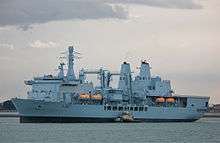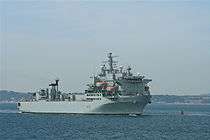Her Majesty's Naval Service
| Her Majesty's Naval Service | |
|---|---|
| Country |
|
| Allegiance | Elizabeth II |
| Role | Naval, expeditionary and amphibious warfare |
| Naval Staff Offices | Whitehall, London, UK |
| Nickname(s) | Senior Service |
| Branches |
Royal Navy ∟ RN Nursing Service ∟ RN Reserve Corps of Royal Marines ∟ RM Reserve ∟ RM Band Service Naval Careers Service |
| Commanders | |
| Lord High Admiral | Prince Philip, Duke of Edinburgh |
| First Sea Lord | Admiral Sir Philip Jones KCB |
| Fleet Commander | Vice Admiral Ben Key CBE |
| Second Sea Lord | Vice Admiral Jonathan Woodcock OBE |
| Insignia | |
| White Ensign[note 2] |
 |
 |
| Her Majesty's Naval Service of the British Armed Forces |
|---|
| Components |
|
|
| History and future |
|
|
| Ships |
| Personnel |
| Auxiliary services |
Her Majesty's Naval Service, also known as the Senior Service, is the United Kingdom's naval warfare and maritime service.[1][2] It consists of the Royal Navy, Royal Marines, Naval Careers Service, Royal Marines Band Service and Queen Alexandra's Royal Naval Nursing Service.[3] The term Naval Service should be distinguished from the "UK Naval Services", which consist of the Naval Service and the Merchant Navy. The Naval Service as a whole falls under the command of the Navy Board, which is headed by the First Sea Lord. This position is currently held by Admiral Sir Phillip Jones (appointed April 2016).[4] The Defence Council delegates administration of the Naval Service to the Admiralty Board, chaired by the Secretary of State for Defence.
The Naval Service is dominated by the Royal Navy, and operates primarily from three bases in the United Kingdom where commissioned ships are based; Portsmouth, Clyde and Devonport, the latter being the largest operational naval base in Western Europe. As of 2014, there are over 180 vessels in service with the various branches of the Naval Service and supporting organisations, including; 77 commissioned ships of the Royal Navy, 33 landing craft of the Royal Marines, 63 auxiliary vessels of Marine Services and 13 auxiliary ships of the Royal Fleet Auxiliary.
The total displacement of HM Naval Service and the Royal Fleet Auxiliary is approximately 641,000 tonnes.
Queen's Regulations for the Royal Navy
Current composition
According to the Queen's Regulations for the Royal Navy[3] the Naval Service consists of:
- The Royal Navy (Royal Naval Reserve) - including Queen Alexandra's Royal Naval Nursing Service
- The Royal Marines (Royal Marines Reserve)
- Naval Careers Service
The Naval Service is also supported by Marine Services (currently provided under a private finance initiative) and the Royal Fleet Auxiliary which both operate a fleet of auxiliaries in support of the Royal Navy. The Royal Fleet Auxiliary is considered part of the Ministry of Defence Civil Service.
Former composition
The following services were formerly also components of the Naval Service:
- The Women's Royal Naval Service (merged into the Royal Navy in 1993)
- The Royal Naval Minewatching Service (reformed into the Royal Naval Auxiliary Service in 1962 and disbanded in 1994)
- The Queen Alexandra's Royal Naval Nursing Service (incorporated within the Royal Navy in 2000)
Naval Reserve Forces:
- The Royal Naval Volunteer Reserve (merged with the Royal Naval Reserve in 1958)
- The Royal Naval Volunteer (Supplementary) Reserve
- The Royal Naval Volunteer (Wireless) Reserve
- The Royal Naval Volunteer (Postal) Reserve)
- The Royal Naval Emergency Reserve (disbanded c. 1959)
- The Royal Naval Special Reserve (disbanded c. 1960)
- The Women's Royal Naval Volunteer Reserve (renamed the Women's Royal Naval Reserve in 1958, merged into the Royal Naval Reserve in 1993)
- The Women's Royal Naval Supplementary Reserve
- The Queen Alexandra's Royal Naval Nursing Service Reserve (incorporated within the Royal Naval Reserve in 2000)
Formerly the Royal Maritime Auxiliary Service, the Royal Fleet Reserve, and the Royal Corps of Naval Constructors were also considered part of the Naval Service.
Composition of the Naval Service
Royal Navy
Referred to as the "Senior Service" by virtue of it being the oldest service within the British Armed Forces, the Royal Navy is a technologically sophisticated naval force and forms the core structure of the Naval Service. The Navy has been structured around a single fleet since the abolition of the Eastern and Western fleets in 1971.[5] Command of deployable assets is exercised by the Commander-in-Chief Fleet, who also has authority over the Royal Marines and the civilian Royal Fleet Auxiliary.[6] Personnel matters are the responsibility of the Second Sea Lord/Commander-in-Chief Naval Home Command, an appointment usually held by a vice-admiral.[7] The United Kingdom's nuclear deterrent is carried aboard the navy's Vanguard-class of four nuclear ballistic-missile submarines. The surface fleet consists of destroyers, frigates, amphibious assault ships, patrol ships, mine-countermeasures, and miscellaneous vessels. The submarine service has existed within the Royal Navy for more than 100 years. The service possessed a combined fleet of diesel-electric and nuclear-powered submarines until the early 1990s. Following the Options for Change defence review, the Upholder class diesel-electric submarines were withdrawn and the attack submarine flotilla is now exclusively nuclear-powered.
Royal Marines
The infantry component of the Naval Service is the Corps of Royal Marines. Consisting of a single manoeuvre brigade (3 Commando Brigade) and various independent units, the Royal Marines specialise in amphibious, arctic, and mountain warfare.[8] Contained within 3 Commando Brigade are three attached army units; 1st Battalion, The Rifles, an infantry battalion based at Beachley Barracks near Chepstow (from April 2008), 29 Commando Regiment Royal Artillery, an artillery regiment based in Plymouth, and 24 Commando Regiment Royal Engineers.[9] The Commando Logistic Regiment consists of personnel from the Army, Royal Marines, and Royal Navy.[10]
-
_Hovercraft_MOD_45154442.jpg)
2000TDX Landing Craft Air Cushion
-

Royal Marines during the annual Cold Weather Training exercise
In support of the Naval Service
Royal Fleet Auxiliary
The Royal Fleet Auxiliary is a civilian-manned fleet owned by the British Ministry of Defence. The RFA enables ships of the Royal Navy to maintain operations around the world. Its primary role is to supply the Royal Navy with fuel, ammunition and supplies, normally by replenishment at sea (RAS). It also transports Army and Royal Marine personnel, as well as supporting training exercises. RFA personnel are members of the Ministry of Defence civil service who wear Merchant Navy rank insignia with naval uniforms and are under naval discipline when the vessel is engaged on warlike operations. RFA vessels are commanded and crewed by these civilians, augmented with regular and reserve Royal Navy personnel to perform specialised military functions such as operating and maintaining helicopters or providing hospital facilities. The RFA is funded out of the UK defence budget and the Commodore commanding the RFA is directly responsible to the Royal Navy Fleet Commander.
The Royal Fleet Auxiliary also augments the Royal Navy's amphibious warfare capabilities through its three Bay-class landing ship dock vessels. The service is manned by around 1,850 civilian personnel.
Marine Services
Marine Services enables Royal Navy and Royal Fleet Auxiliary Ships, including the United Kingdoms Strategic Nuclear Deterrent, to either move in or out of port for operational deployment and training exercises around the world. The service operates a large assortment of vessels including tugs and pilot boats as well as transporting stores, liquid and munitions and providing passenger transfer services to and from ships for officers and crew. Serco Denholm took over Marine Services to the Naval Service from the now disbanded Royal Maritime Auxiliary Service in 2008. In late 2009 Serco bought out Denholm's share, with the service now being known as Serco Marine Services.[11]
-
.jpg)
SD Northern River, a Marine Services multi-purpose ship
-
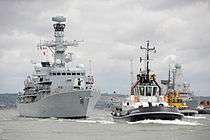
SD Bountiful, a Marine Services ATD 2909-class tug
-

SD Navigator, a Marine Services Multicat 2510-class recovery vessel
Lists of vessels
See the articles below for lists of vessels operated by or in support of Her Majesty's Naval Service:
- List of active Royal Navy ships - 76 (plus two non-commissioned training vessels)
- List of active Royal Marines military watercraft - 35
- List of active Royal Fleet Auxiliary ships - 12 (plus five ships under charter)
- List of ships of Serco Marine Services - 63
See also
- British Armed Forces
- Royal Navy
- Royal Marines
- Royal Fleet Auxiliary
- Her Majesty's Coastguard
- Border Force
Notes
- ↑
- English Empire (until 1707)
- British Empire (1707–19th century)
- ↑
 1630–1707
1630–1707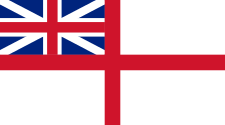 1707–1800
1707–1800
References
- ↑ NAVAL PERSONNEL HIERARCHY, mod.uk. 5 October 2014.
- ↑ Her Majesty’s Naval Service Eligibility and Guidance Notes, mod.uk. 5 October 2014.
- 1 2 "Queen's Regulations for the Royal Navy" (PDF). Ministry of Defence. Retrieved 29 August 2013.
- ↑ "First Sea Lord | Royal Navy". www.royalnavy.mod.uk. Retrieved 2016-06-29.
- ↑ Hampshire (1975), The Royal Navy Since 1945: its transition to the nuclear age, p. 248.
- ↑ Fleet Command and Organisation, armedforces.co.uk
- ↑ https://www.royalnavy.mod.uk/static/content/209.html
- ↑ BBC News (2002), UK's mountain warfare elite, news.bbc.co.uk
- ↑ The Commando Role for 1 RIFLER, army.mod.uk
- ↑ Commando Logistic Regiment, royalnavy.mod.uk
- ↑ Bush, Steve (2014). British Warships and Auxiliaries. Maritime Books. p. 64. ISBN 1904459552.
- BR 2 - Queen's Regulations for the Royal Navy
- BR1806 - British Maritime Doctrine, Glossary
- United Kingdom Defence Statistics 2005 - glossary


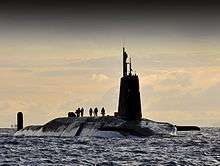
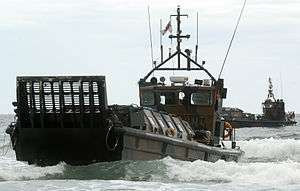
.jpg)
